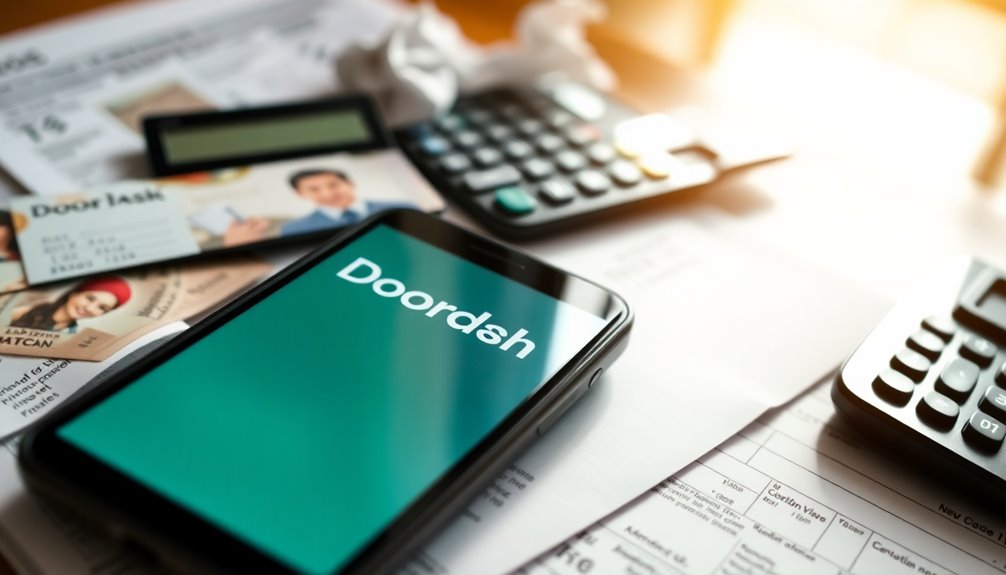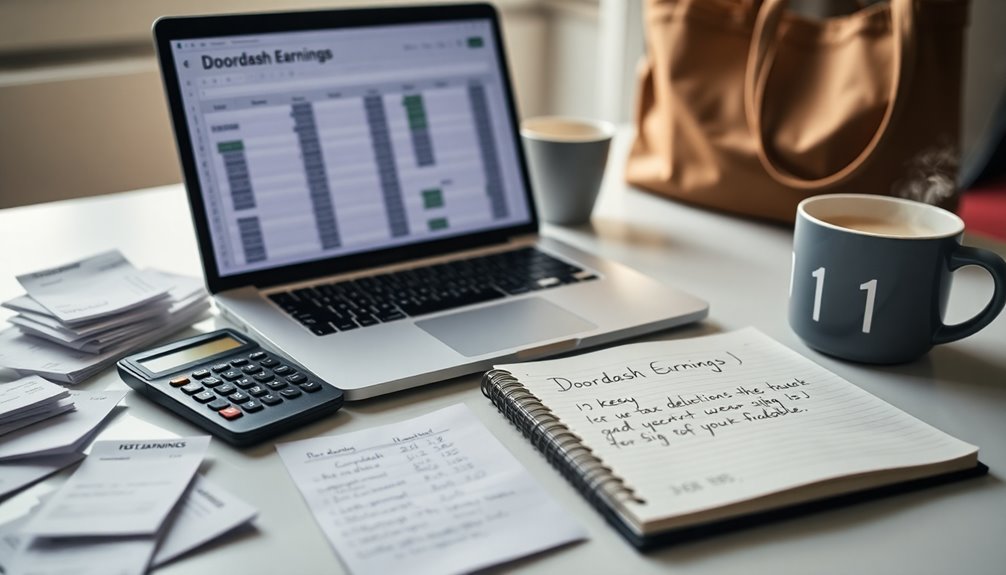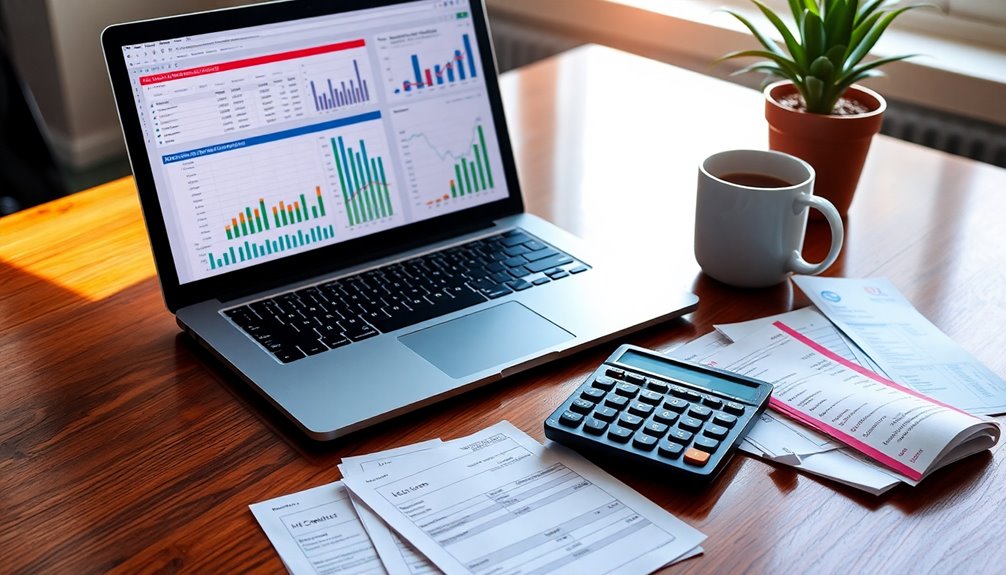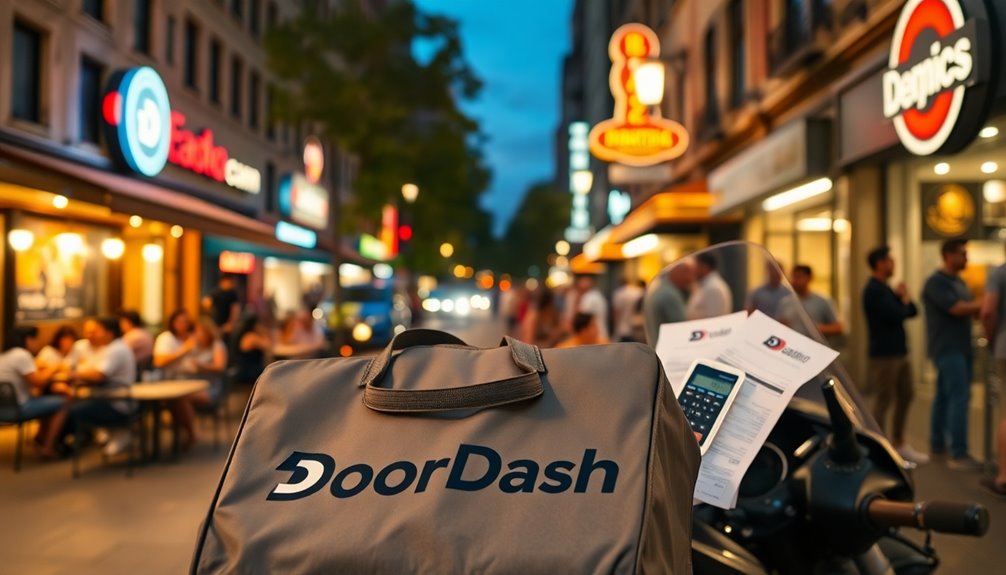Driving for DoorDash can definitely be worth it, but it's essential to factor in your tax responsibilities. As an independent contractor, you won't have taxes withheld, so you'll need to manage federal and state taxes yourself, which can range significantly. After considering self-employment taxes and eligible deductions—like vehicle expenses and service fees—you might find your net earnings lower than expected. Generally, if you effectively schedule your deliveries, you can earn a decent income. Want to know more about maximizing your earnings and minimizing tax liabilities? There's plenty to uncover in this gig economy!
Key Takeaways
- After tax deductions and liabilities, DoorDash earnings can significantly decrease, so understanding your net income is crucial to evaluate worth.
- Average earnings per trip stand at $7.78, which may be less appealing after self-employment taxes are factored in.
- Drivers must account for expenses like vehicle maintenance and gas, which can reduce taxable income but also lower net earnings.
- Peak demand hours can increase earnings, making scheduling important to maximize income potential after taxes.
- Regularly tracking expenses and setting aside funds for taxes helps maintain a clearer picture of actual earnings and financial viability.
Understanding DoorDash Earnings

When you dive into understanding DoorDash earnings, it's crucial to grasp how the pay structure works. Your earnings consist of base pay, promotions, and tips. Base pay ranges from $2 to $10 or more per order, depending on the distance and estimated delivery time. For less popular deliveries, you'll see a higher base pay to encourage you to take those orders.
On average, you can expect to earn about $7.78 per trip, with hourly rates around $13.55, which is somewhat lower than other delivery apps. However, your earnings can vary based on when and where you work. Choosing to deliver during peak demand can significantly increase your hourly rate, especially if you take advantage of promotions like peak pay and challenges. Additionally, keep in mind that customer ratings can influence tip amounts, potentially enhancing your overall income.
Daily earnings typically range from $115 to $125, depending on the hours you put in. Keep in mind that effective scheduling and strategic planning can lead to better results.
Lastly, remember that you keep 100% of the tips you receive, which can boost your overall earnings. Understanding this structure will help you maximize your potential as a DoorDash driver.
Tax Responsibilities for Drivers

As a DoorDash driver, understanding your tax responsibilities is essential for managing your finances effectively. Since you're classified as an independent contractor, DoorDash doesn't withhold taxes from your earnings. This means you're responsible for paying federal and state income taxes, along with self-employment taxes totaling 15.3% of your taxable income. Additionally, it's important to note that self-employment tax is calculated on your net earnings, which can significantly impact your overall tax bill.
If your annual tax liability exceeds $1,000, you'll need to make estimated quarterly tax payments due on April 15th, June 15th, September 15th, and January 15th. Failing to pay these on time can lead to late fees and penalties from the IRS.
Keep accurate records of your earnings and deductible expenses to help estimate these payments. You can deduct costs like mileage, gas, vehicle maintenance, and even health insurance premiums related to your DoorDash work. Maintaining detailed logs using a mileage tracker simplifies this process.
Consulting a tax professional can also ensure you understand your specific obligations and maximize your deductions. By staying organized and informed, you can navigate your tax responsibilities confidently and keep more of your hard-earned money.
Required Tax Forms

Understanding the required tax forms is crucial for DoorDash drivers to ensure accurate reporting of their income. If you earn over $600 in a year, you'll receive a 1099-NEC form from DoorDash, typically sent via your Stripe Express account by January 31 of the following tax year. This form details your total earnings, including base pay, tips, pay boosts, and any milestones achieved.
If your earnings fall below that threshold, you won't receive a 1099 form, but you're still required to report that income. The 1099-NEC reports nonemployee compensation and has replaced the 1099-MISC for this purpose. You'll use it to report your income on your tax return, specifically on Form 1040.
Additionally, if you've driven for multiple platforms, make sure to gather all relevant income tax forms. If you have other employment, you might also need W-2 forms. It's important to remember that as independent contractors, Dashers are responsible for their own taxes, which means no taxes are withheld by DoorDash.
Don't forget about quarterly estimated tax forms if you owe $1,000 or more in taxes, and remember to use Schedule C to report your business expenses and income accurately.
Choose between electronic or paper delivery for your 1099, ensuring your tax information is correct for seamless delivery.
Self-Employment Tax Breakdown

Self-employment tax can feel daunting, but it's essential for DoorDash drivers to grasp its implications on their earnings. In 2024, the self-employment tax rate is 15.3%, which includes 12.4% for Social Security and 2.9% for Medicare.
As a self-employed individual, you pay both the employee and employer portions of FICA taxes. This rate applies only to the first $168,600 of your earnings for Social Security. If your net earnings exceed $200,000 as a single filer (or $250,000 jointly), an additional 0.9% Medicare tax may apply. Self-employment tax applies to net earnings from self-employment, making it crucial to accurately report your income.
To calculate your taxable income, you'll subtract business expenses from your gross income. Generally, 92.35% of your net earnings are subject to this tax, and you only owe it on earnings above $400 in a year.
Since self-employment taxes can significantly reduce your net income, it's crucial to understand this impact. For instance, if you gross $1,000, you might only take home around $850 after taxes.
Unlike traditional employees, you don't have taxes withheld, and you'll cover the entire FICA tax amount, making it vital to factor these costs into your overall earnings.
Key Deductions for Dashers

For DoorDash drivers, taking advantage of key deductions can significantly boost your bottom line.
Start with vehicle and transportation expenses. You can deduct $0.56 per mile driven for deliveries. Additionally, costs like gas, maintenance, parking fees, and tolls related to your deliveries can be written off. Don't forget about vehicle depreciation over time, which can also offer tax relief. Keeping detailed records of your deductible mileage is essential for maximizing these deductions.
Next, consider equipment and supplies. If you use insulated courier bags to keep food warm, those costs are deductible. You can also write off a portion of your cell phone expenses if it's used for DoorDash activities. Health insurance premiums and retirement contributions can further reduce your taxable income.
Service and fee expenses are also important. Any fees or commissions you pay to DoorDash are deductible, as are costs for necessary vehicle inspections and repairs. Be sure to include a portion of your car insurance and payments if you use your vehicle for deliveries.
Lastly, miscellaneous business expenses can add up, too. Deductions for business use of your home, meals while on the job, and advertising expenses can all help improve your tax situation.
Tracking Business Expenses

When you're on the road as a DoorDash driver, keeping track of your business expenses becomes crucial to maximizing your earnings. Using mileage tracking tools with GPS can help you document every mile driven while working. It's essential to maintain detailed mileage logs that include the date, distance, and purpose of each trip. Remember, the IRS allows a standard mileage deduction of $0.56 per mile, which covers costs like gas and maintenance.
Besides mileage, you should track other expenses too, like parking fees and insulated bags. Apps that let you snap photos of your receipts simplify this process, allowing you to categorize expenses effectively. Many also offer auto-tracking features that sync with your bank accounts. Ensure your records are accurate and organized under specific tax categories to comply with IRS regulations.
These detailed reports not only help during tax season but also prepare you for potential audits. With user-friendly interfaces and integration capabilities, these apps make managing expenses easier, so you can focus more on driving and less on paperwork. Additionally, maintaining accurate expense tracking can help you maximize tax deductions, ultimately reducing your overall taxable income.
Impact of Taxes on Earnings

Although driving for DoorDash can provide flexibility and potential earnings, taxes play a significant role in your overall take-home pay. As an independent contractor, you're responsible for federal and state income taxes, which can range from 10% to 37% federally and 0% to 13.3% at the state level.
Additionally, you need to pay self-employment taxes totaling 15.3% of your taxable income, covering Social Security and Medicare. Since DoorDash doesn't withhold taxes, you might face a hefty tax bill at the end of the year, especially if your earnings exceed $600, which gets reported to the IRS.
The difference between gross and net income can be surprising; your net income is significantly reduced after taxes and any applicable deductions. You can deduct expenses like mileage and car maintenance, which can help lower your taxable income. Moreover, understanding self-employment tax is crucial as it encompasses both employee and employer portions, totaling 15.3%, impacting your financial planning.
However, if you earn more, you might get pushed into higher tax brackets, increasing your overall rate. So, it's essential to factor these tax implications into your earnings to assess whether driving for DoorDash truly meets your financial goals.
Planning for Quarterly Taxes

Planning for quarterly taxes can feel daunting, but understanding the process helps you stay on top of your finances. Start by estimating your annual income from all gig-related activities, including DoorDash and any other self-employment sources.
Next, identify deductible expenses like mileage, vehicle maintenance, phone bills, and supplies. These deductions can significantly lower your taxable income. Remember that if your net earnings are at least $400, you must file a tax return to comply with IRS regulations.
Once you have your estimates, calculate your tax liability using IRS tax rates, then divide that amount by four to determine your quarterly payments. Be mindful of the payment due dates: April 15th, June 17th, September 16th, and January 15th of the following year.
You can pay online via IRS Direct Pay or by mailing a check—just ensure it's postmarked by the deadline.
Regularly review your income and expenses, adjusting your estimates if circumstances change throughout the year. Keep detailed records of your payments and consider consulting a tax professional for tailored advice.
Staying organized and proactive in your planning will help you avoid penalties and ensure you're prepared for tax season.
Evaluating Overall Earnings Viability

Evaluating your overall earnings viability with DoorDash requires a clear understanding of both gross and net income. Your gross income includes base pay, peak pay, and tips, all of which are fully taxable. If you earn more than $600 in a year, this income will be reported on the Form 1099-NEC, and you'll need to consider federal and state income taxes, which can significantly impact your take-home pay.
To calculate your net income, subtract applicable taxes and deductions from your gross earnings. Self-employment taxes, which are 15.3% for Social Security and Medicare, as well as federal income taxes ranging from 10% to 37%, will affect your final amount. Estimated taxes may also need to be paid quarterly, particularly for those owing over $1,000.
State taxes can vary widely, so keep that in mind based on your location. Additionally, don't overlook potential tax deductions that can enhance your net income. You can deduct mileage, car maintenance, and even supplies for your deliveries.
Tips for Financial Management

Managing your finances as a DoorDash driver can significantly impact your overall earnings. Start by tracking all your expenses and mileage related to your deliveries. Use apps like MileageWise for automatic logging, and don't forget to record gas, maintenance, and toll fees. These will all be crucial when you deduct business expenses at tax time. Additionally, keeping a detailed budget can help you monitor your income and expenses more effectively, ensuring you're aware of your financial health as a driver.
If you use your vehicle for DoorDash, you can also deduct a portion of your car insurance and payments, as well as phone usage that's specifically for work.
Next, manage your tax obligations wisely. Set aside about 30% of your earnings for self-employment taxes, and consider making quarterly estimated payments to avoid penalties. Remember, you can deduct half of your self-employment taxes on your tax returns. Additionally, it's important to track all mileage driven for work to maximize your tax deductions.
Utilize every tax deduction available to you, including equipment and materials necessary for your job. Keep receipts for all work-related expenses to support your claims.
Finally, maintain accurate financial records throughout the year. Regularly reviewing your income and expenses will help you assess your budget and adjust your strategies to ensure compliance with IRS requirements. Doing this will help maximize your earnings and keep your finances in check.
Frequently Asked Questions
How Can I Maximize My Deductions as a Doordash Driver?
To maximize your deductions as a DoorDash driver, start by tracking all your work-related expenses meticulously.
Use apps for mileage and gas, and don't forget to save receipts for parking and tolls.
Deduct vehicle expenses or opt for the standard mileage rate.
You can also write off delivery-related equipment and services.
Lastly, consider health insurance and the qualified business income deduction to further reduce your taxable income.
What Expenses Are Commonly Overlooked by Dashers?
As a Dasher, you might overlook several common expenses.
Don't forget to track your mileage, as it's a significant deduction. Gas, maintenance, and insurance costs also add up, so keep records of those.
Additionally, expenses for insulated bags, phone accessories, and health gear can help lower your taxable income.
Lastly, consider any business-related apps or training costs that you may not think to include in your deductions.
Are There Any Tax Credits Available for Gig Workers?
Yes, there are tax credits available for gig workers like you.
The Earned Income Tax Credit (EITC) can significantly reduce your tax bill if you meet specific income and family requirements.
If you have qualifying children, you might also benefit from the Child Tax Credit, which provides additional savings.
Make sure to check your eligibility, and keep accurate records to claim these credits effectively on your tax return.
How Do I Calculate My Net Earnings for Tax Purposes?
To calculate your net earnings for tax purposes, start by determining your gross income from all earnings, including DoorDash.
Next, subtract all applicable taxes, like federal and self-employment taxes.
Then, deduct your business expenses, which may include mileage, vehicle maintenance, and other costs.
Keep accurate records to support your deductions.
Finally, adjust your net earnings based on any estimated quarterly tax payments you've made throughout the year.
What Should I Do if I Can't Pay My Tax Bill?
If you can't pay your tax bill, don't panic.
First, file your tax return on time to avoid penalties.
Then, consider setting up an installment agreement with the IRS to spread your payments over time.
Communicate with the IRS about your situation; they might offer temporary hardship relief.
Keep detailed records of all interactions and payments to stay organized.
Seeking advice from a tax professional can also help you navigate your options effectively.
Conclusion
In conclusion, deciding if DoorDash is worth it after taxes depends on your earnings, expenses, and how well you manage your finances. Keep track of your deductions, plan for quarterly taxes, and evaluate your overall income to see if the effort aligns with your financial goals. By staying organized and informed, you can maximize your earnings and make DoorDash a profitable venture. Ultimately, it's about finding the right balance that works for you.









